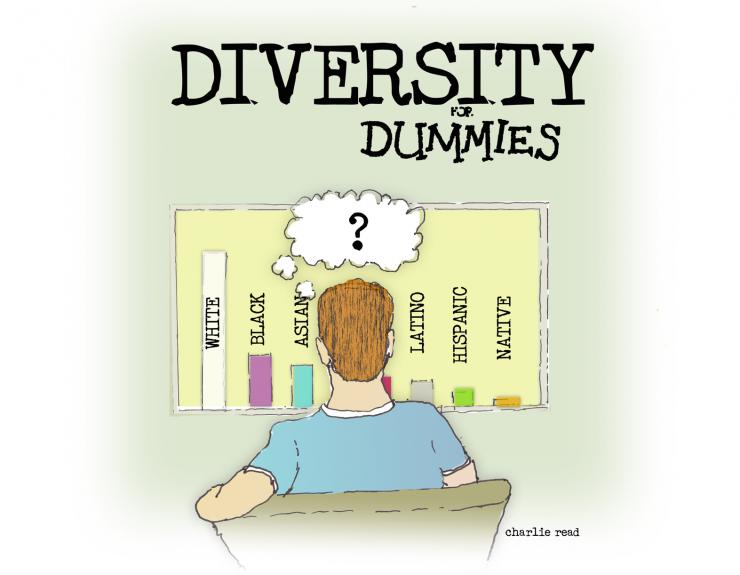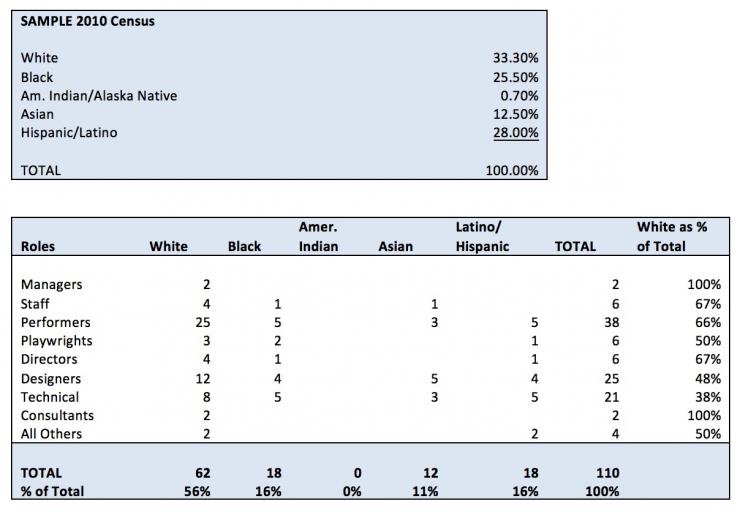Diversity for Dummies

The first thing to say about this quickstart manual is that I’m a dummy myself. In all the years I’ve grappled with diversity, the one constant has been recalibration. What was diverse ten years ago is privileged today, and today’s diversity models will become obsolete in the coming years. Historically disenfranchised groups are just now finding their voices after decades, even centuries, of silence. Diversity requires periodic check-ins, assessment, and retuning.
I think it’s fair to say that the theatre community is committed to the ideals of diversity. This guide will focus on implementation, which can be trickier. And while every exercise in diversity must include gender, physical abilities, and age (to name just a few), this guide will focus on ethnic diversity.
Here are a few ways you can check on your theatre’s diversity smarts.
It’s Not Really About Numbers—But Look at Them Anyway
Diversity is not a numbers game, but a quick look at your digits can be telling. How many people of color work in your back office? How many artists of color perform on your stages? Divide those numbers by your total employees, and the total number of artists you employed for the season. What number do you get?
Compare that number to your community’s demographics. Don’t use your ticket subscriber base, use the population of the geographic area in which you operate. Don’t gerrymander or redistrict your sample area. Is your diversity percentage a close approximation of your area’s ethnic diversity? If not, why not?
Here’s a sample comparison between New York City’s 2010 ethnic demographics and a hypothetical theatre company’s organizational and season programming numbers. The total columns at the bottom and the far right have a story to tell. It may not be the full story, but it deserves close investigation.
If your theatre has been around ten or twenty years, take a look back to see how your organization and programming lines up with the demographic changes in your community over time. That may tell another story.
Don’t lump all peoples of color into one category. One ethnic group is not a surrogate for the other. In other words, just because you hired four Black actors for the season, you’re not off the hook from hiring performers of other ethnicities.
Here’s a link to the US Census Bureau, where you can look up your city’s data.
I think it’s fair to say that the theatre community is committed to the ideals of diversity. This guide will focus on implementation, which can be trickier.
Who’s in Charge?
Let’s look at agency, and the power to make decisions.
Look at your organization’s hierarchy. Who are the top decision-makers? Who has the power to advance a play into production? For many theatre organizations, one person holds this power.
Who are the other gatekeepers in your organization? This includes your literary managers, casting directors, and associate producers. Oftentimes, they are the sentries who give or deny access to your theatre. Is diversity a part of their operational objectives? Are they empowered to open your theatre’s doors to artists of color?
Putting managers of color in these positions is important—as important as providing them with the training and work environment to succeed.
White men run a majority of theatres in the United States and that needs to change. Not because white men are incapable of empathy or because they don’t have a sense for what’s right or wrong—we need diverse leaders because it drives innovation, adaptability, and organizational smarts. Diverse thinking is crucial in navigating a world in flux and, ultimately, in how the theatre responds to its changing environs.
Who’s on Stage?
I have heard artistic directors and managing directors boast of how diverse their organization is. “Our back office is a veritable Rainbow Coalition!”
But wait. Aren’t you running a theatre? How diverse are the faces you put on stage? What opportunities are there to diversity your casting practices?
Are you color conscious when you choose a play? How white is Thornton Wilder’s Grover’s Corners? What about Shakespeare’s Elsinore? How about Tobias and Agnes’s household in A Delicate Balance? Is ethnicity a marker of historical accuracy? There are many arguments for and against “authenticity,” which we won’t parse here. What’s important is that you’re aware of the implications of your decisions and how they affect who gets on stage.
This might be a good time to touch on the implicit canard in the term “colorblind casting.” It is not meant to provide cover for casting white actors in roles written for performers of color. It is not meant to allow a theatre to cast a white actor as Martin Luther King, Jr., by invoking the “what’s good for the goose” argument, or the “if we’re truly after equality, then any actor can play any role.” Why not? Because colorblind casting is intended to correct a gross inequity in American theatre, where more than 75 percent of all roles go to white actors. Calling on the goose/gander equation doesn’t work because inequality is the current norm. A tit for tat proposal only works when all parties are on equal footing, so that for every tit, the corresponding tat is intended to rebalance the equation.
Who’s Watching?
Do you have a subscriber base? How does it break down ethnically? Why? Does your pricing exclude certain communities? How about your marketing outreach? What has shaped your audience makeup over time?
Here’s a big hurdle for some theatres. When the audience watching is overwhelmingly white, why should a theatre care about choosing plays that are not? For the majority of theatres that find themselves in this position, there’s a good chance they’ve already proven to themselves that their audiences are delighted by diverse programming. Theatre audiences are voyeurs at heart and relish being able to look into lives other than their own.
But there’s a more important and compelling reason to present a multiplicity of perspectives to our audiences: empathy. Forces that underscore differences and divisions shape our world today. Theatre can propose a compelling alternative by putting a human face on “the other” and stressing the truism that we are more alike than we are different. If we do this often enough, theatre can be an agent for change.
Note that I inserted a caveat in that last sentence. “If we do this often enough…” One-offs won’t do it. I can’t tell you how many times I’ve heard this refrain, “We did an Asian play, but Asian audiences didn’t come.” You can’t expect to mobilize a community that you’ve ignored in the past. You have to engage, and engage again, and again. And again. You have to earn its trust.
This is true for audiences and communities of all colors.
Theatre can propose a compelling alternative by putting a human face on 'the other,' and stressing the truism that we are more alike than we are different. If we do this often enough, theatre can be an agent for change.
It’s Going to Cost You
Diversity requires dedicated resources. You have to invest in it.
As a business proposition, it’s a no-brainer. According to the US Census, just “over half – 50.2% – of U.S. babies younger than 1 year old were racial or ethnic minorities. In sheer numbers, there were 1,995,102 minority babies compared with 1,982,936 non-Hispanic white infants.”
This is what drove Google to increase its workforce diversity initiative budget from $115 million in 2014 to $150 million in 2015.
No theatre has $150 million to spend on a diversity initiative, but a close and honest look at your organization will likely reveal practices that should be made more inclusive. But let’s talk about the scary stuff: box office/earned revenue.
Theatres are terrified of losing income because they took a chance on a play their audiences are not familiar with, or “can’t relate to.” A sea of empty seats is a scary sight, but as I said previously, you can’t expect them to come if you’ve never put in the work. It’s also wrongheaded to put up a play featuring Asian American actors and assume the Asian American community will come rushing to your doors. Don’t blame the community if they don’t know you.
This is where the investment opportunities come in.
Put more muscle into your outreach programs. Consider going to communities of color and presenting work there. Not everyone can come to you. Make the first move, and keep making moves. Earning trust takes time and tenacity.
Prepare for the possibility of reduced box office revenue. This may not happen. In some cases, the opposite could be true—a box office bonanza. But there are risks in choosing unknown artists—that is, artists not familiar to your theatre patrons. These are the risks you have to take, not once but multiple times, until your audiences no longer think of diversity as a concession and begin to accept it as the norm.
Cast a wider net. Diversity is not low-hanging fruit that you can pick and enjoy without much effort. You have to work at it. Sometimes you won’t get enough actors of color to respond to your casting call. Maybe no plays by writers of color crossed your desk for consideration this season. Don’t give up. Go out and get them. Call your colleagues and ask for referrals. Partner with community organizations to get the word out. Make noise and let the world know you want it.
Last Word
This guide is meant to stop theatres from paying lip service to diversity. Giving a playwright of color five workshops without ever producing the play may earn you the heterogeneity badge, but it falls way short of making your theatre an exemplar of diversity.
You have to try harder than that.











Comments
The article is just the start of the conversation—we want to know what you think about this subject, too! HowlRound is a space for knowledge-sharing, and we welcome spirited, thoughtful, and on-topic dialogue. Find our full comments policy here
Hi Ralph, I love the tone and openness of your article. May I have permission to steal some of your proposed ideas?
Absolutely. And it's not stealing, we're sharing. :-)
Sounds good. Thanks!
Will I see you at TCG this year?
I had planned on it but I have a gig that starts at the same time.
I once again have to point to out to a howlround contributor that hiring or not hiring someone based on race is a violation of the Civil Rights Act. If a theatre recieves federal funding--while said funding exists--you cannot take a look at your staff and start discriminating based on race.
I also am a little shocked that you would ask theatres to *lose money* in pursuit of your ideological goals.
I think you can take a look at your stuff and realize that you might already have been discriminating based on race, and not even realized it. Or at the very least, you might have been drawing from a more limited talent pool than might be beneficial to your organization (if you truly believe diversity of experience and viewpoints are critical for building strong organizations). Bringing diversity to your organization does not require you to suddenly start hiring based solely on race (that would be illegal), but you can work to actively diversify your talent and applicant pool.
Theatres lose money all the time in pursuit of artistic and ideological goals. Not all shows make money. Making money might not be the most important criterion for the success of a show. And even in the long-term business sense, if a company realizes that its long-term survival requires engagement with a more diverse audience, that might require upfront costs that will ultimately be realized down the road.
I think that's fair, but here is where it breaks down ethically: Let's say you want to hire a new AD and it comes down to a white man and a white woman. Do you go ahead and consider gender the deciding factor? I don't think that's acceptable.
I would like to see colorblind casting and blind submissions, but I don't want artists/staff to be broken down into race/gender/sexual factors when it comes to hiring. I see this philosophy casually thrown around all the time at howlround in the name of justice and I think we're moving in the wrong direction.
But your philosophy only works if the starting point is an absolutely level playing field, with people of all races and genders fairly hired and employed. Instead, what exists now is a state where many, many generations of policies and discrimination have given us a state of employment where whites, males, and especially white males are vastly over-represented. You can't have a completely unfair system and distribution and then expect that you can achieve a fair system without considering race and gender in hiring. Note that this does not state or even imply that you are going to hire less qualified individuals. But given applicants of generally equal qualifications, you would hire the candidate will bring about a more diverse workforce.
It's a much bigger ethical problem to cheat entire groups of people for decades/centuries and then say, "well, yeah, sorry about that, but we can't do anything to specifically to rectify the problems that we caused for the people who were cheated, because we need to treat everyone the same now (and that might eat into the unfair advantage that we gained by cheating you for so long)."
So you are explicitly calling for people to be judged by race as a form of justice. I'm sorry, I know our history, I know how unforgivably unjust things have been. But this is *still* wrong.
I ask you flat out: Is it ethical to judge people based on race/gender/sexuality? Yes or no? Nobody ever answers this. Because we *know* it's wrong.
We can fight for equality without doing this. We have been leveling the playing field for the last 50 years, in which we peacefully and quietly and quickly transitioned from a 90% white population to a 65% white population. And we accomplished this by practicing NOT judging people on race/identity. Change is not fast enough and not good enough, but now we're advocating a reversal of the liberal principles that have actually worked in the past.
We were on our way, and it's not our enemies shutting down progress. We're doing it ourselves.
Besides, theatre is run on cronyism, not racism or sexism.
You are saying you want equality. I'm saying I want equity. You can start treating people equally right now. But in a system without equity, disparities in opportunity and achievement will continue to perpetuate, even with equal treatment.
You claim to know our history, but if you think we have stopped judging people based on race/identity over the past 50 years, you are sadly mistaken. Numerous studies show that whites continue to have privilege and preference in housing and employment. Women continue to be paid less then men for the same work. The playing field is not even close to level.
I don't understand what you mean when you say "We were on our way, and it's not our enemies shutting down progress. We're doing it ourselves." What does that mean? Support this statement in some way.
I think others in theatre would volunteer that our profession has plenty of racism and sexism to go around, in addition to cronyism.
Again, I'm not saying to hire people, or to choose work, based solely on race. I'm saying that within a certain grouping of qualification or quality, choosing a candidate or play that diversifies a theatre's staff or season is not just ethical, it's intelligent and forward thinking, and necessary.
You are asking for equality of outcome. You want equity? This would require all participants to be broken down by racial and gender factors and assigned roles independent of their actions or experience and having roles distributed in relation to indentity population size. That's what it would take for equity.
You are talking about racial quotas, Patrick. This is enforced equity which does not value the individual, Patrick. You are saying that the deciding factor should be race or gender. Do you not see this as illiberal? Personally, I find it insane.
We have made progress in the last 50 years. I didn't say it was good enough, not by a damn sight, but now the left wants to reverse course from stating that race/gender/sexuality SHOULD NOT MATTER to preaching that it's all that matters. You just said so, as in that hypothetical situation, race would be the deciding factor. It is the left, my left, pushing these policies. It is not the cultural right pushing for quotas, censorship, and equality of outcome in a race/gender based system. It's us.
You did not answer my yes or no question. Y or N? Is it ethical to judge based on race, gender or sexuality?
I'm not saying THE deciding factor should be race or gender, but I'm saying that if you believe that diversity in the workplace or creative sphere is important and valuable, you can only achieve that by taking race and gender as A factor. It is ethical to include this as a factor, if the goal of including it is to fight the results of generations of entrenched racism and sexism. Indeed, it is unethical to pretend that somehow suddenly ignoring (or pretending to ignore) race and gender will lead to a just workplace and a season that presents diverse points of view. If you're running an institution, and want a breadth of experience and viewpoints on your staff, and voices on your stage, you MUST be conscious of who you are hiring and what they're bringing.
It is ethical for it to be a factor, but that's not what I'm witnessing. IMO, we've become obsessed with this factor to the point of violating title VI of the Civil Rights Act. We've gone too far.
And perhaps we were "pretending" that race didn't matter, but we did transition and we DID become a multicultural society in about the time between episode IV of Star Wars and the last of the prequels. I'd say that's a better, proven formula for change, the one we adopted after the Civil Rights movement, the one that valued the individual, not the identity obsessed, censorious, illiberal, resentful, fragile and spiteful politics of privilege that is shuttering speech and demanding ideological purity across the academy and the arts. If the race of the artist, or the gender of the artist, or the sexuality of the artist is what we are obsessed with--and any rational person would admit these are the issues being obsessed over--and what is discussed endlessly...We have a problem.
Hm. I would posit that our society and culture has always been obsessed with race and gender. It's woven into the very fabric of America, into our founding documents, and the struggle for people of color and women continues to this very day. I don't think you can blame the Left or artists for discussing these issues of identity (or being obsessed with them), when we see a presidential campaign waged by a candidate who espouses blatantly racist and misogynistic views. When we have a sitting vice president who claims to be uncomfortable to be alone in a room with a woman who is not his wife. When white supremacists commit mass murder in churches. When states work to limit women's access to healthcare. When people are barred from entering our country because of religion or national origin. If the people who are being directly affected by this state of the world are not presented with prominent opportunities to have their voices heard, then that's the problem.
Look, we fundamentally disagree. My principles will not change when confronting these real world problems. In fact, principles of equality--not equity--freedom of expression and speech are how to address these issues. The left does not value these freedoms as they used to. Howlround has published essay after essay calling for censorship and demanding ideological conformity. These are not good ideas.
I simply will not judge anyone based on race, gender, or sexuality, as *they are totally unreliable* factors. I judge people on what they do. I do not understand why this is controversial.